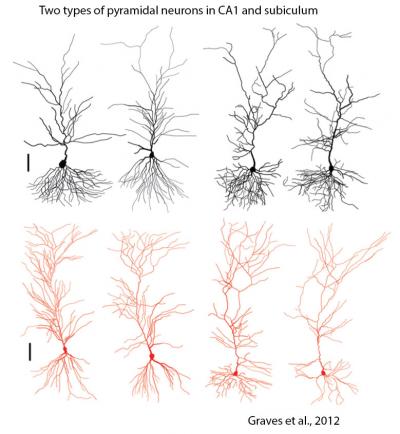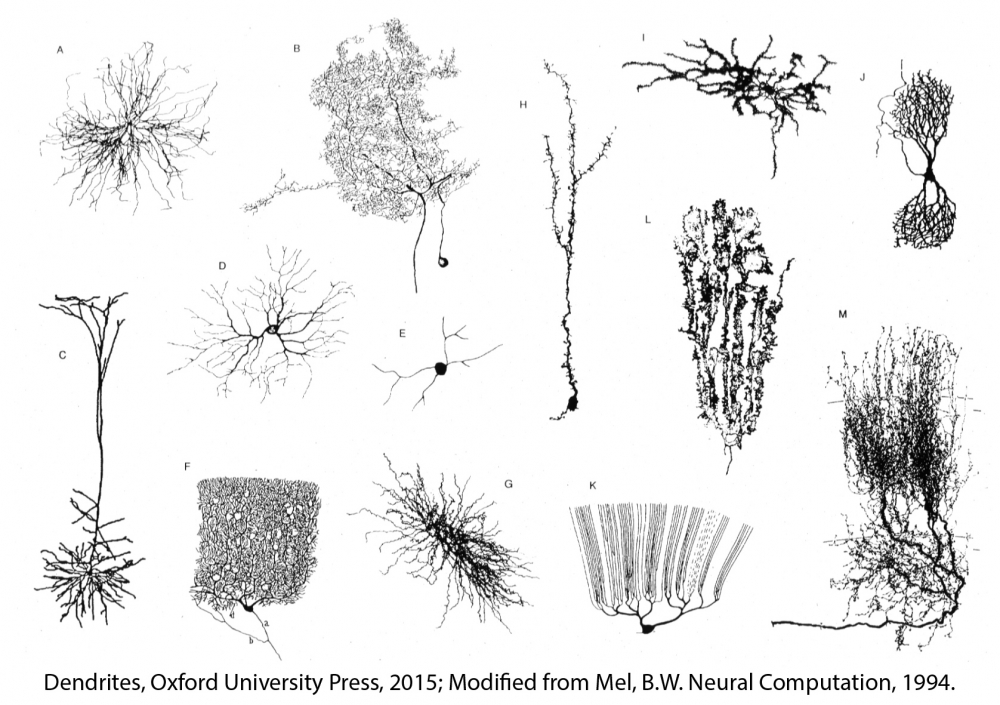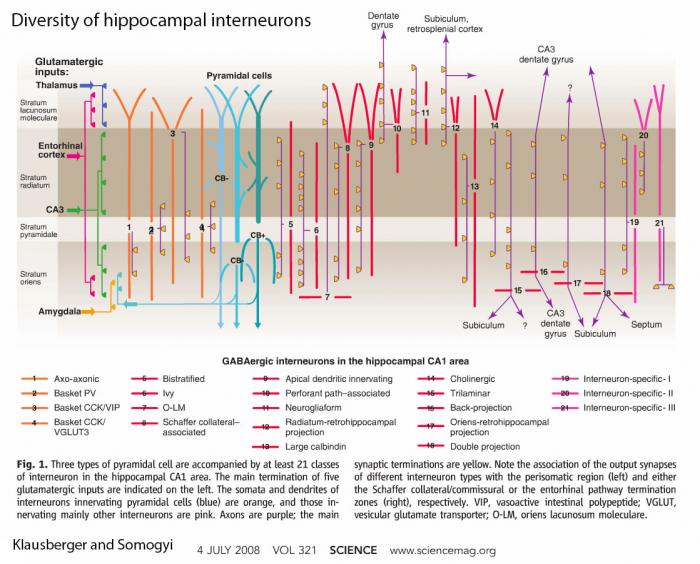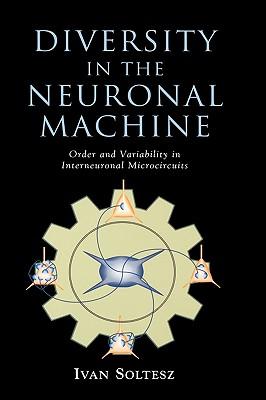The previous pages about dendritic integration should make it clear that neurons are very complex machines. They are also diverse. Ever since Cajal created his panoply of neurons in many brain regions and many species, it has been clear that neurons are morphologically diverse (Andres-Barquin, 2001).
Since then, myriad neurophysiological studies make it clear that this morphological diversity reflects extensive functional diversity. One impressive example of the morphological and functional diversity of neurons is in the hippocampus, where more than twenty types of inhibitory interneurons have been described in the CA1 region alone (Klausberger and Somogyi, 2008).
Although the complexity of neurons within a brain region is most readily displayed in the case of inhibitory interneurons, morphological and functional diversity of excitatory projection neurons is also evident. In the neocortex, for example, several types of pyramidal neurons can be found, and in the hippocampus, pyramidal neurons in CA1, CA2 and CA3 are clearly distinct (Spruston, 2008; Kohara et al. 2013). Even within CA1 and subiculum (the major output structures of the hippocampus), we have found two distinct types of pyramidal neurons, which differ in their morphology, physiology and plasticity (Graves et al., 2012).
 We are currently pursuing three projects related to cellular diversity in the hippocampus (see right-side menu). David Hunt is continuing our effort to determine the functional diversity of pyramidal neurons in the hippocampus, including the CA3 region. Tara Deemyad is continuing our effort to understand the mechanisms of retroaxonal barrage firing in hippocampal interneurons. Mark Cembrowski is using next-generation RNA sequencing, as well as in situ hybridization and immunocytochemistry, to explore differences in gene expression across a range of cell types in the hippocampus.
We are currently pursuing three projects related to cellular diversity in the hippocampus (see right-side menu). David Hunt is continuing our effort to determine the functional diversity of pyramidal neurons in the hippocampus, including the CA3 region. Tara Deemyad is continuing our effort to understand the mechanisms of retroaxonal barrage firing in hippocampal interneurons. Mark Cembrowski is using next-generation RNA sequencing, as well as in situ hybridization and immunocytochemistry, to explore differences in gene expression across a range of cell types in the hippocampus.
References
Andres-Barquin PJ. Ramón y Cajal: a century after the publication of his masterpiece. Endeavor 25:13-17, 2001.
Graves AR, Moore SJ, Bloss EB, Mensh BD, Kath WL, Spruston N. Hippocampal pyramidal neurons comprise two distinct cell types that are countermodulated by metabotropic receptors. Neuron, 76:776-789, 2012.
Kohara K, Pignatelli M, Rivest AJ, Jung HY, Kitamura T, Suh J, Frank D, Kajikawa K, Mise N, Obata Y, Wickersham IR, Tonegawa S. Cell type-specific genetic and optogenetic tools reveal hippocampal CA2 circuits. Nature Neuroscience 17:269-279, 2014.
Klausberger T, Somogyi P. Neuronal diversity and temporal dynamics: the unity of hippocampal circuit operations. Science 321:53-7, 2008.
Spruston N. Pyramidal neurons: dendritic structure and synaptic integration. Nature Reviews Neuroscience, 9:206-221, 2008.
Further reading
Fishell G, Rudy B. Mechanisms of inhibition within the telencephalon: "where the wild things are". Annual Review of Neuroscience 34:535-67, 2011.
Kepecs A, Fishell G. Interneuron cell types are fit to function. Nature 505:318-26, 2014.
Klausberger T, Somogyi P. Neuronal diversity and temporal dynamics: the unity of hippocampal circuit operations. Science 321:53-7, 2008.
McBain CJ, Fishan A. Interneurons unbound. Nature Neuroscience 2:11-23, 2001.
Spruston N. Pyramidal neuron. www.scholarpedia.org/article/Pyramidal_neuron
Also see the gallery at the bottom of the page.






